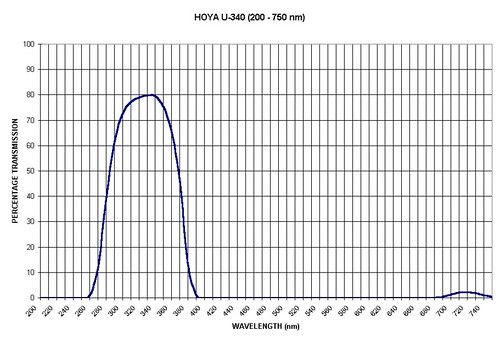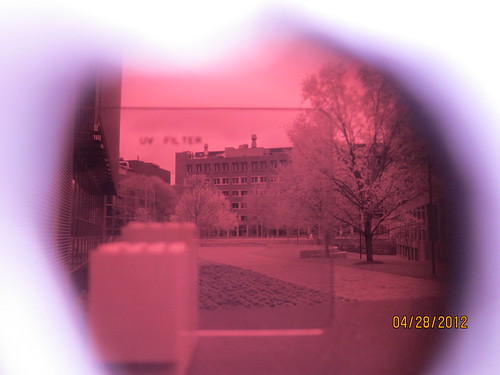We're using a Hoya UV-pass filter which we bought from UQG Optics, but you can buy it on Edmund Optics as well for $26.50. Here are some of its specs:
U-340 12mm Diameter Bandpass Filter Stock #: NT46-096 Thickness (mm) 2.50 Center Wavelength CWL (nm) 340.00 Full Width-Half Max FWHM (nm) 85.00 Density (g/cm3) 2.92 Diameter (mm) 12.0 Dimensional Tolerance (mm) ±0.25 Thickness Tolerance (mm) ±0.2 Surface Quality 80-50
Its spectral profile is shown in this graph:
Though our CMOS camera could probably sense pretty low here, it's limited by the glass lens, which blocks a lot of UV light. We're not sure where the cutoff is.
The camera we used is the Canon SD4000 IS, which is a rear-illuminated CMOS camera. We removed the hot mirror filter, and added the Hoya UV-pass filter to the front. Rear-illuminated CMOS sensors are very sensitive in the UV range, as shown in this spectral sensitivity curve:

More soon from Alex McCarthy, as to the uses of this camera in identifying petroleum contamination with UV-fluorescence spectroscopy.
Here's a photo showing the image half-blocked with a simple UV filter which I believe is just a sheet of thick glass:



5 Comments
That looks great!!! Sorry if it sounds stupid but ... it is kind of ... romantic looking :D ! I can't wait to try these cameras out in the Gulf!!!
Reply to this comment...
Log in to comment
Yeah... i was photographing flowers because i've heard that they look quite different in the UV range, since many pollinating insects can see UV.
Reply to this comment...
Log in to comment
Check out photomultipliers : "These detectors multiply the current produced by incident light by as much as 100 million times (i.e., 160 dB), in multiple dynode stages, enabling (for example) individual photons to be detected when the incident flux of light is very low. [...] Photomultipliers can be used to detect photons from 115nm to 1700nm. [...] Discover the applications suitable for a : - photomultiplier, including - Chemiluminescense detection - Bioluminescence detection - Fluorescence detection - Flow cytometry - Environmental analyzers - Non-destructive test and measurement instrumentation - Photon counting - Gene chip scanners - Particle counters - Spectrophotometry - Radiation counters and probes - Surface inspection and laser scanning - Astronomical instrumentation - Industrial materials inspection"
This is how it works : http://learn.hamamatsu.com/articles/photomultipliers.html I really like this, http://sales.hamamatsu.com/en/products/electron-tube-division/detectors/photomultiplier-tubes.php
Reply to this comment...
Log in to comment
Are you sure this is real UV photography and not simply IR? I see a lot of IR contamination. Leaves and flowers are really too bright and it is well known sensors without hot mirror have a lot QE for near-IR wavelenght rather than low-UV). If you want to test for sure the IR leakage try to photograph some flower's pattern like those reported for the Asteracee plants.
Is this a question? Click here to post it to the Questions page.
Reply to this comment...
Log in to comment
thanks for the suggestion. I sent the UV camera off to another PLOTS chapter but hope to get it back soon. The Hoya 340 filter we're using does not list any significant IR leakage, so I'm moderately confident. I'd like to test it with a spectrometer though. which luckily we also have been working on.
Reply to this comment...
Log in to comment
Login to comment.